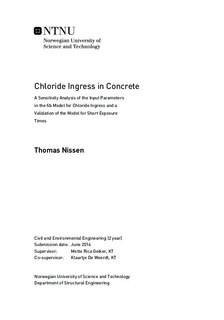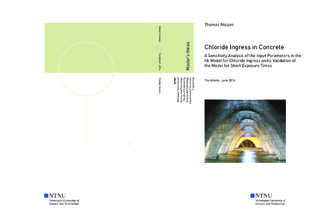| dc.description.abstract | Chloride transport in concrete is a rather complex process. There are numerous different models one can use to estimate chloride ingress in concrete. The fib model code presents a model based on an error function solution to Fick s 2nd law, called the fib model. The fib model is relatively simple to use compared to other approaches. In this model, a difference in concentration is the driving potential for the chloride transport. It is assumed that the concrete is crack free, homogeneous and that the chloride ingress is one dimensional at macro-scale.
The aim of this thesis is to investigate which of the fib model input parameters that have the highest level of sensitivity and how the model performs as a tool for predicting the transport of chlorides into concrete for an exposure time of 2 and 5 years. To accomplish this, a sensitivity analysis, a differential analysis and a comparison between exposure data and predictions made by the fib model will be performed.
From the sensitivity analysis, we see that the chloride surface concentration, the ageing exponent, the chloride migration coefficient and the depth at which we want to know the chloride content has a large impact on the predicted chloride content. A large change in the chloride content is observed when these parameters are varied from the highest to the lowest value within their range. A small variation in these parameters will also have a significant impact on the chloride content. From the differential analysis we see that the ageing exponent and the depth at which we want to determine the chloride content are the parameters with the largest absolute value of the first order sensitivity coefficients, almost two times larger than the apparent diffusion coefficient and the surface chloride content.
A change in the transfer variable and the parameter that describes the temperature of the structural element or the ambient air results in a small change in the chloride content. The parameter with the least influence on the chloride content is by a large margin the regression variable.
The input parameters that have the largest sensitivity and therefore needs to be determined with a high level of accuracy is the ageing exponent, chloride migration coefficient, chloride surface concentration and the depth at which we want to determine the chloride content. Parameters that are less important and can be used with a bigger scatter without influencing the model to a critical degree is the transfer variable, the regression variable and the temperature of the structural element or the ambient air.
Predictions made by the fib model for concretes containing fly ash is not adequately accurate. For concretes composed of OPC the predictions made by the fib model is quite accurate. For an exposure time of 5 years, the fib model slightly underestimates the chloride content at depths greater than 25 mm. After 2 years we see a slight overestimation. The fineness of the cement has an impact on the predictions, a coarse cement blend gives a more accurate prediction than a fine cement blend. | |

